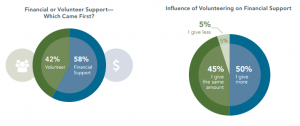October 26, 2017
One of the best parts of my profession involves being a tireless seeker of truth, and by extension, information. It’s been a part of me forever. When I was growing up minor arguments would erupt at the dinner table that would be solved by me rushing to the bookshelves, grabbing a World Book Encyclopedia volume, and pointing out where I was right and Mom and/or Dad was wrong.
Hopefully, I’ve developed a bit of humility and diplomacy where the Information is the important part and not the Being Right part.
That’s what happens when a great deal of one’s childhood free time is spent with the World Book — just grabbing a volume at random and going through it, page by page, for hours. It’s a pity these don’t exist anymore — my daughter would perhaps get into it as she’s a big reader herself.
So it’s no surprise that I’m still to this day a walking collection of random facts. One of my efforts these days involves researching some of the deeply-held tenets of volunteer and donor behavior. I’m essentially asking “Are you SURE about that?” and questioning why we pursue the approaches we do.
I’m sure sometimes my Boss hates it. Especially when I don’t have the modern equivalent of my World Books close at hand.![]()
Back in the Spring, I had a meeting with a CEO of an energy company, who was spearheading a data analysis project. He said the whole process was basically questioning the common, anecdotal wisdom that ranged from “that’s the way we’ve always done it” to forecasting models that seemed to rely more on the Aztec calendar, and couldn’t easily be explained or verified.
One of our big questions here at the United Way is “Financial or Volunteer Support — Which Came First?” The Assumption: people get acquainted with social service causes by volunteering, and then as they mature in their careers they continue to volunteer or switch to donations and volunteering.
A 2014 research paper by Fidelity Charitable entitled TIME AND MONEY: The Role of Volunteering in Philanthropy examines this within their population of donors. Fidelity Charitable was the very first Donor-Advised fund, not unlike our own Tulsa Community Foundation, so one can assume similar behaviors of these two populations. Among their findings:
- Volunteers are more likely (58%) to support a nonprofit financially before volunteering
- While younger donors are more likely to volunteer, they spend fewer hours overall; donors near retirement age volunteer more hours for more organizations
- In 2013, 23% of all Americans volunteered, and 51% of those volunteers gave 50 or more hours per year
- Most volunteers in the U.S. were involved in One (71%) or Two (19%) nonprofit organizations
 So while this flies a bit in the face of our “life stage escalator” approach to migrating someone from a volunteer to a donor, their data on volunteers might be skewed a bit toward their population, which is divided between 50 and Under, and Over 50. As befits a survey of well-heeled folks who choose to become philanthropists. Their 2009 survey contains more demographic data that we can assume remains fairly constant.
So while this flies a bit in the face of our “life stage escalator” approach to migrating someone from a volunteer to a donor, their data on volunteers might be skewed a bit toward their population, which is divided between 50 and Under, and Over 50. As befits a survey of well-heeled folks who choose to become philanthropists. Their 2009 survey contains more demographic data that we can assume remains fairly constant.
As we develop better processes to plumb the depths of our data to make good decisions, it’s worthwhile to keep questioning “Why?” and “Are you Sure?” to commonly held assumptions. Some of these assumptions may have been valid, but as companies change and Tulsa is not the one-industry town that it once was, we have to remain aware that change might be pushed onto us by outside forces, like some of those I outlined in my earlier “Tulsa: 2047” article.
So whether it’s determining if our new single-use coffee cups are truly recyclable, or trying to determine whether volunteers become donors or vice-versa, it’s all about research and learning around here. Feel free to comment if you have an opinion, but don’t be surprised if I throw a World Book Encyclopedia at you…
[…] about who our donors were, and more important, how to get people “on the escalator.” I wrote an earlier post that included survey results from Fidelity’s Charitable Donor Advised Fund that examines […]